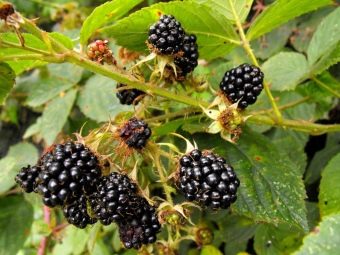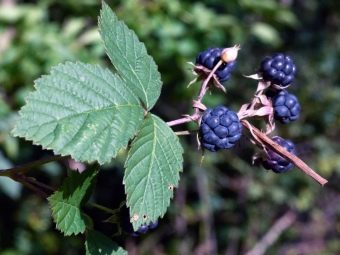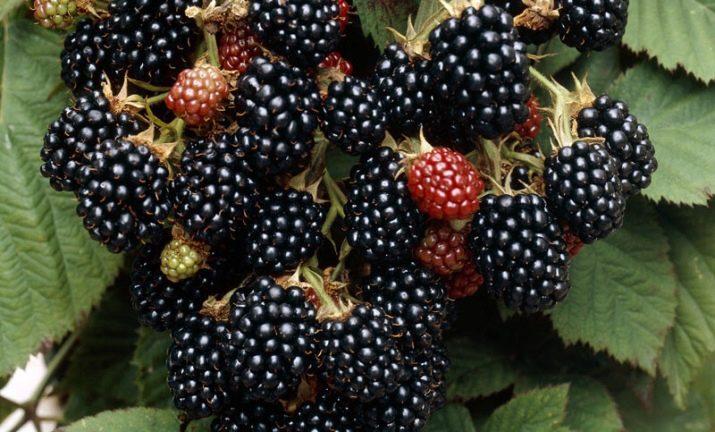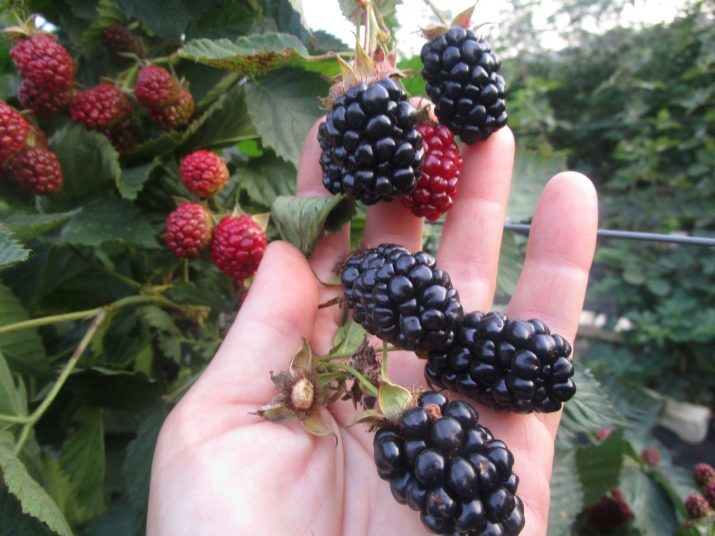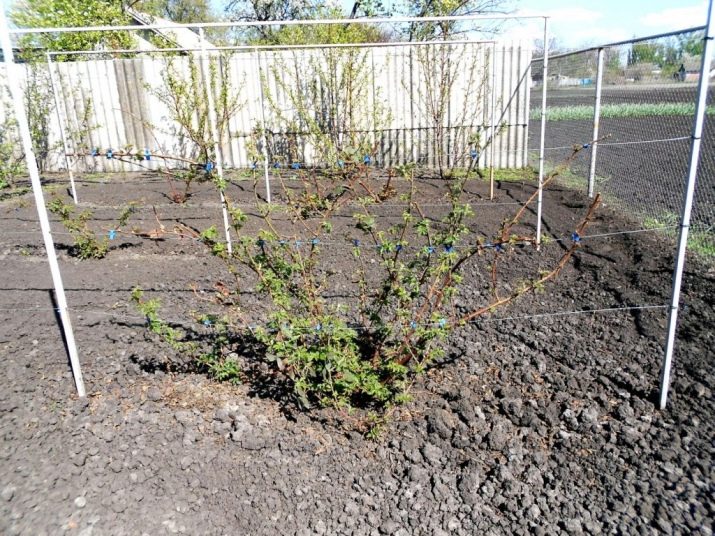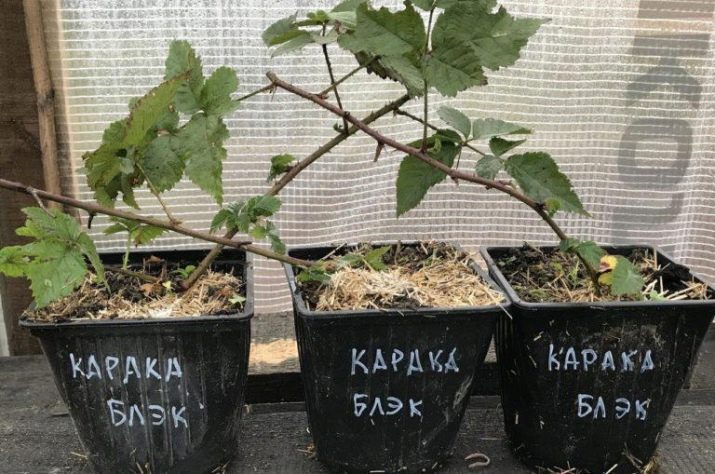Rules for planting, care and preparation of blackberries for the winter
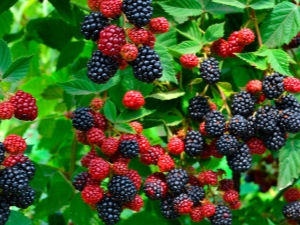
The fashion for growing blackberries came to us from North America.But unlike most other fashionable trends, this borrowing is welcome. To gardeners were not disappointed, they should thoroughly understand the characteristics of such a plant, before trying to grow it.
Varieties and varieties
Blackberry garden is gaining popularity and in the coming years will be able to make a full-fledged competition to raspberries. This culture:
- gives big berries;
- allows you to collect large yields;
- has an impressive taste;
- does not require complex care.
The main part of the wild-growing blackberry found on the territory of Russia and other states of the Eurasian continent is the bushy and gray variety. But, besides them, there are several other types of blackberry shrubs, which give edible berries. Giant species (in a number of sources called the Himalayan) for many decades dominated in foreign horticulture. He gave a significant amount of large berries, differing sweet taste. However, over time, an excessively large number of thorns pushed gardeners from this plant.
With the appearance in the back of a split blackberry, which does not have thorns, the Himalayan variety is increasingly rejected. On all continents, the popularity of varieties bred on the basis of bushy and gray species is steadily growing. Wild-growing blackberries are distinguished by the fact that ripening berries from green ones become at first red or brown; then acquire a dark purple, sometimes almost black color. In blackberry, the rind of the berries is covered with a special coating, while for other varieties such a sign is absent.
Particularly noteworthy is the so-called split blackberries. This type of plant has leaves with a strongly dissected edge. Also characteristic for him are brushes formed by a mass of berries, and creeping flexible branches. Busy and bluish blackberry residents of our country can almost be everywhere to watch:
- on the forest edges;
- in overgrown logging sites;
- on the slopes of ravines;
- on the river banks.
But nevertheless these plants were introduced into culture were only efforts of breeders. Long-term work of nerds has significantly increased the size of the fruit and their number. Any blackberry variety that is found now is bred from several wild ancestors. This was manifested in the fact that garden perennials differ in the structure and structure of fruiting. A significant part of the varieties inherited from their ancestors the tendency to climb along the ground.
Those varieties that give long shoots should be grown on the trellis. This technique significantly increases the collection of fruits from each plant. But the bush varieties in their appearance closer to raspberries. They begin to produce crops when two-year-old shoots appear. Spray blackberries can stretch up to 2, even up to 2.5 m. That's why pruning becomes very important.
Gardeners who want to facilitate pruning and other manipulations are more likely to prefer thornless varieties. It is easy to recognize them - the term “Thornless” is present in company names. He is so literally translated and - no thorns. Another problem that farmers face is a long vegetative period. In spring and early summer, this property is useful, but later maturation of the crop, or even leaving the ovaries under snow (in the northern regions) can cause a lot of trouble.
The output is the use of blackberry remontantnaya, which gives berries all season. But to limit the choice of one or another variety "in general" will not work. Gardeners need to familiarize themselves with the varieties of berry bushes and make the right choice among them.
A review of varieties is appropriate to start with Thornless Evergreen. This culture was the result of a mutation of dissected blackberries and - not least! - mutation occurred in the wild.
Seen unusual plants in the early twentieth century allowed to create a variety that:
- keeps green color all year round;
- brings a large number of fruits;
- does not form a thorn.
Evergreen blackberry berries are not as large and heavy as in newer varieties. However, this circumstance is largely offset by a record number of fruits. The inflorescence may account for 60 and even 70 ovaries. Ripe blackberries become a thick blue color, sometimes smoothly turning into a black tone. They are characterized by an attractive smell and rich sweet-sour taste.
The leaves of the blackberry "Evergreen" differ in openwork structure and at the same time significant density. They retain their attractive colors even under a layer of snow. When spring comes, growth begins swiftly. New flowers will appear just as quickly. It should be borne in mind that this variety of blackberry gives large seeds.
Of the newer varieties, Black Satin is an attractive alternative. This plant also does not have thorns and creates powerful bushes. To a height of 2 m shoots develop strictly in a straight line, grow upwards. But after this mark, they show their semi-subsistence character. When it comes time to ripen the fruit, shoots reach a length of 4 or even 5 m.
On the branches are formed berries of medium size. Their mass varies from 5 to 8 g. As the crop ripens gradually, it is removed for a very long time. In culinary terms, the taste of Black Sateen fruits is considered universal, suitable for use in any dishes and combinations.
If farmers want to try the original modern variety, they need to choose the “Natchez” blackberry.
This plant was introduced into circulation by breeders in the US state of Arkansas in 2007. In all descriptions and reviews, it is noted that with the observance of the norms of agrotechnology it is possible to collect large (8 and even 10 g each) berries. Harvest time - from July 1 to the end of August. The fruits are oblong, the seeds in them are relatively small, and the pulp is juicy and has a pleasant aroma.
The harvest of the Natchez blackberry can be kept fresh for several days or transported for a relatively short distance. But if farmers do not want to experiment, and want to get a guaranteed result, they need to pay attention to more traditional varieties. Such as the "Agave". Such a blackberry gives shiny, elongated berries in the sun. You can collect them in August.
Fruits from long (up to 3 m) shoots are harvested in the second year of vegetation. But there is a mandatory requirement: a winter shelter. It is created even in the warmest Russian regions. The harvest time takes approximately 30 days. The quality of them is quite decent, characterized by a universal taste.
Another option - blackberry remontant varieties "Ruben". This hybrid can produce fruit on the shoots of both the first and second year of vegetation. The first berries can be collected in July. The “second wave” of fruits (weighing 10-16 g) falls on August 20 - September 30. In the total amount, the harvest also makes farmers happy; Another advantage of Ruben is its excellent resistance to frost.
Those who have already tried some of the varieties listed can diversify their plantings using the Navajo blackberry-free spines. It gives large erect bushes (1.5-2 m). Grow the "Navajo" is obtained with little care, not even need to use the support. Fruit harvesting is carried out throughout August. The severity of a berry varies from 5 to 7 g.
When is it better to plant?
Continue to review the different varieties of blackberry, their advantages and disadvantages can be long. But for those who are already preparing to land in the country, practical information is much more important. And it is just more or less the same for all existing varieties. Blackberries are planted in both spring and winter. At the beginning of the season, you must hurry to get ahead of the onset of kidney growth.
Autumn planting is most often planned for the last days of September or for the beginning of October. At this moment, the weather is usually still warm and clear. Therefore, the chances are greatest that the blackberry will have time to take root before the onset of sustained cold weather. And working in such conditions is much easier and more pleasant than in the late autumn. It is recommended, of course, to look at the actual weather and conditions in a particular region.
Experienced gardeners mostly transplant spiky blackberries in the spring. At the same time they try to move the plant along with the earthy clod. The reason is the fragility of the root system. If summer is good, the bush takes root in a new place and almost does not undergo winter freezing. Is that with very strong frosts and a snowless winter problems can arise.
Choice of place
Having decided on the blackberry planting time, you need to find out where it should grow. Blackberries, like raspberries, do not tolerate the winter cold and frost in the spring months. And therefore it is recommended to choose the most warm, well-warmed parts of the sun. It is unacceptable that cold winds blow on them. Such a wind in the winter dries out shoots, increases the risk of freezing of the bark and kidneys.
It is unacceptable to plant a plant in areas that are blown by winds from the north or from the east. Also avoid ravines and lowlands, where cold air is concentrated as long as possible. For the same reasons, slopes facing north and east are undesirable. In addition to climatic considerations, it is necessary to take into account soil parameters. Blackberry bushes can grow well and bear fruit on moderately wet soils.
These soils should be composed of fertile soil with thorough drainage. As for the mechanical composition of the earth, light and medium loams are best suited. If the dacha is located on a land full of sandy loam, the situation must be corrected. For this purpose, form the underlying layer. It is laid out of loam that is abundantly absorbing moisture with a total thickness of up to 0.5 m.
Blackberry, giving upright shoots, gives the best results on a light deep loam. But creeping species can develop well on solid ground. The fact is that their root system goes deeper. But of particular importance is the permeability of the subsoil layer to air. He should also be moderately moist.
Growing blackberries in deep sand gives conflicting results. We'll have to carefully monitor the normal supply of landings moisture. Both excessive scarcity of moisture, and poor drainage are extremely bad for the condition of the shrub. Even if a short-term flooding happens, the roots can suffer greatly. Almost always it ends with the death of plantations, despite all efforts to save them.
Strictly unacceptable landing of blackberries on the ground, rich in carbonates. These compounds impede the absorption of magnesium and iron. Ideally, you should choose areas with a light acid reaction (acid-base balance value 6). It is very good when, before planting, blackberries grew at the same place:
- cereals;
- beans;
- field herbs;
- beans;
- vegetables.
Of sideratov used in the middle lane, the best results give:
- a mixture of peas with oats;
- a mixture of wiki with oats;
- phacelia;
- mustard.
To help plants grow, grown siderats are crushed and plowed into the ground. In private gardens it is recommended to plant in spring in areas allocated for blackberry:
- cucumbers;
- squash;
- zucchini;
- beet table;
- carrot.
Important: while these crops grow, you need to protect them, ruthlessly eliminating weeds. The following year, the plot is filled with feathery onions or fodder beets. To free the land from these sideratov need early. It is also required to maintain it in a loose, weed-free state up to the landing of the blackberry.
If you are not satisfied with planting vegetables, you can sow mustard, legumes or buckwheat instead. These plants mow as soon as they begin to bloom. Then buried in the garden. But for all the benefits of natural farming, other techniques are required.It is recommended to prepare the ground for planting blackberries for at least 2 or 3 years, saturating it with useful substances in advance.
Thus, the normal development of green manure is impossible without specific fertilizers. Yes, these cultures help to improve the quality of the land, but if it is favorable for them, the result will only get better. When the preceding blackberry culture is removed, fertilizers of mineral and organic origin are placed in the ground. On personal garden plots, it is customary to fold the soil out of the furrow together and mix it with fertilizers. On 1 square. m. landings should account for 10 kg of organic compounds.
The amount of superphosphate on the same area varies from 10 to 16 g, and potassium sulfate - from 20 to 30 g. The exact volume is determined individually, starting from the properties of the earth, from improving its composition with the help of siderats. Also need to take into account the needs of a particular variety of blackberries Warning: if the land is already fertile, the application of organic fertilizers is not recommended. This provokes abnormally rapid growth and prevents the formation of fruit.
Over-wet areas can also be a place to grow blackberries. Then you just have to choose hills or ridges for it. If necessary, such elevations are formed artificially. If the moisture is not enough, the grooves for planting blackberries simply do not fall asleep to the end. It is advisable to plant landing compactly.
Allowed the location of the blackberry on the outer borders of the gardens. You can place them along the fence from the east or west with wire trellis. Landing is a single-row or two-row method. It is advisable to choose a place where there is a building nearby, covering up from the wind and accumulating solar heat.
How to plant seedlings correctly?
Growing blackberries implies that the depth and width of the landing sites correspond to the size of the planting material. You also need to consider how well prepared the soil is. Furrows or pits are located 0.7-1 m from the border of the site or the nearest wall. Rows of blackberry set parallel to these lines. Attention: if the row is short (no more than 2 m), it is allowed to have it perpendicular to the southern fences.
To grow the blackberry as efficiently as possible, the distance between the holes is selected according to the ability of the variety to form shoots and the method of cultivation. The gaps of rows range from 2 to 2.5 m. The distance of adjacent holes in the same row should be done from 0.75 to 1.5 m. If the cluster method is chosen, preference is given to the scheme 1.8 x 1.8 m. Those bushes that give many shoots, need to grow alone.
Skillful application of modern agrotechnical techniques allows growing blackberries in the open field even in Siberia. There excellent results can give varieties with high resistance to frost. It:
- Black Satin;
- Thornfrey;
- "Abundant";
- "Darrow";
- The Agavam.
Best of all blackberry in Siberian conditions grows when landing in the spring. This allows for good rooting of the shrub before the onset of winter cold. Additionally, it is possible to prevent the freezing of landings. Be sure to take care of a decent level of illumination. Cereal and leguminous plants are preferred as precursors.
In order for blackberries to grow more efficiently in Siberia, it is necessary to clear the area of all trash, weeds and roots. Soil should also be dug up on 1 bayonet of a shovel deep. Before digging the land is improved, contributing to 1 square. m .:
- 10 kg of good humus;
- 0.2 kg of ash;
- 0.02 kg of potassium sulfate;
- 0.015 kg of superphosphate.
Since the climate of Siberia is very harsh, you should not risk using planting material of dubious quality. Because completely unacceptable:
- insufficient moistening of the root system;
- atypical color cuttings;
- the slightest traces of mold.
Long-distance transportation of seedlings requires wrapping them with a damp cloth. As an option, apply filling with slightly wet sawdust. After that, wrap the blackberry film.This will avoid drying the roots as long as possible. Important: in all regions of Siberia, you should carefully consider the weather forecasts. The slightest risk of soil frost requires postponing planting.
Blackberry growing in the Urals has its own characteristics. Shrub will begin to bloom in May, and fruits can be collected in the last part of July and in the first days of August. Landing is practiced in the autumn and in the spring months. But still it is necessary to give preference to spring planting, to prevent the freezing of plants. It is recommended to avoid overly acidified and poorly lit land.
The root kidney of creeping plants when planting is oriented upwards. If growing blackberry bushes grow directly, it is immersed in the ground at 0.01-0.02 m. If the planting is compacted, fertilizing should be done more intensively than usual. When there are no problems with free space, you can safely give BlackBerry space. This will only improve the result achieved.
It is advisable to pinch the bushes at a height of 0.25 m. Such a technique will help teach the plant to grow horizontally. Autumn watering is prohibited. This slows down the transition of the blackberry to hibernation. But if the earth is very dry, this rule can be neglected; and yet it would be more correct to water the areas under the blackberry bushes in advance.
If it rains, even moderate, they stop watering in the fall. Immediately before a steady cooling culture is required to cover. In the Urals, Kumanika is normalized to 3-4 shoots. In dews leave 5-8 shoots. It is necessary to shorten plantings twice or three times during the growing season to avoid turning the garden into impassable jungle.
Less stringent requirements are imposed when growing blackberries in the suburbs. There you can plant and species without thorns, and rosjanik, and kumaniku. But it is important to understand that plants necessarily cover. Otherwise, they are difficult to survive even short-term frosts. Stronger cold is worse.
As in other regions, it is advisable to plant near a fence or other fence. If this condition is not observed, the juicy and sweet harvest is pointless to wait. Experienced farmers near Moscow choose the southern and western sides of the plots. Soil can be both fertile and folded from loams. It is not advisable to choose places without shading.
Regardless of the region of cultivation, there are general requirements for planting blackberries. Thus, the maximum range of planting material offered in the fall. But in the spring nurseries often narrow the offer - a considerable part of the varieties do not survive the cold period. Strictly warming up the soil is a mandatory requirement. When autumn landing land prepare for 14-20 days.
In any case, when choosing a variety, preference should be given to zoned varieties. The most convenient in the sense of planting and care are varieties without thorns. But their layout is strictly stem cuttings. If you apply root cuttings, you can get a prickly bush. Annual seedlings that have developed roots should have shoots at least 0.005 m thick.
Saplings with a closed root system take root in almost 100% of cases. The main thing is to meet the key requirements for planting care. If you use drip irrigation, intensively feed the plants and use other methods of intensive farming, you can grow 40 bushes per 1 hectare. Of course, this approach is used only with sufficient experience and a significant amount of free time.
The supports for blackberries should have a diameter of 0.08-0.15 m. These pillars of reinforced concrete or wood should be deepened to 0.5-0.7 m. Organic fertilizers should be made no later than 6 months before planting. Otherwise, the return will be excessively small. The trench method of planting is justified if 4 or more seedlings are planted.
Care rules
Tie blackberry to the trellis should be as soon as possible. A common mistake is the hope of placing supports, "when there will be a need."Those who put up poles in advance or plant bushes near the fence are doing the right thing. The speed of vegetative development in them is very high. And in the midst of summer there will be a lot of work on the site without it, especially since it is almost impossible to predict the direction of growth of a randomly developing blackberry.
It is necessary to care for blackberries, conducting a systematic formation of the bush. It includes:
- inflorescence cut in the first year of development;
- shortening the stems in the second year to 1.5-1.8 m in height (cutting the escape above the bud);
- removal of all frozen fragments after the end of winter;
- thinning in the first decade of June.
How to prepare for winter?
Preparing blackberries for the winter implies mandatory shelter from the cold. Stems have to bend to the ground. Important: this procedure is carried out before the air is cooled to - 1 degree. If you are late, the bush may break. Usually the branches tie like bundles and attach with hooks. In August, insignificant loads are hung on the ends of the branches of upright varieties: they will gradually tilt the shoots down.
Covering your own hands in the fall requires all kinds of blackberry. Their resistance to cold does not matter much. For cover use:
- vegetable tops;
- sawdust;
- ruberoid;
- fresh peat;
- humus.
Preparation usually begins when the last part of the crop ripens. But it is important not to miss the necessary time. A special danger for all grades of blackberry is a snowless winter. Even if there is no stable snow cover only at the beginning of the cold season, shelter is created in advance. In winter, snow is specially showered at this shelter.
Since blackberry stalks do not peryut, it is permissible to cover them from excessive moisture also with polyethylene. For your information: it is impossible to cover planting with leaves of fruit crops. Lapnik fit much better, because it also protects against rodents. Strict adherence to the principles of care and cultivation exactly help to achieve a brilliant result. We wish you success in the cultivation of blackberries and not only her!
On the rules of planting blackberry and caring for it, you will learn from the video below.



